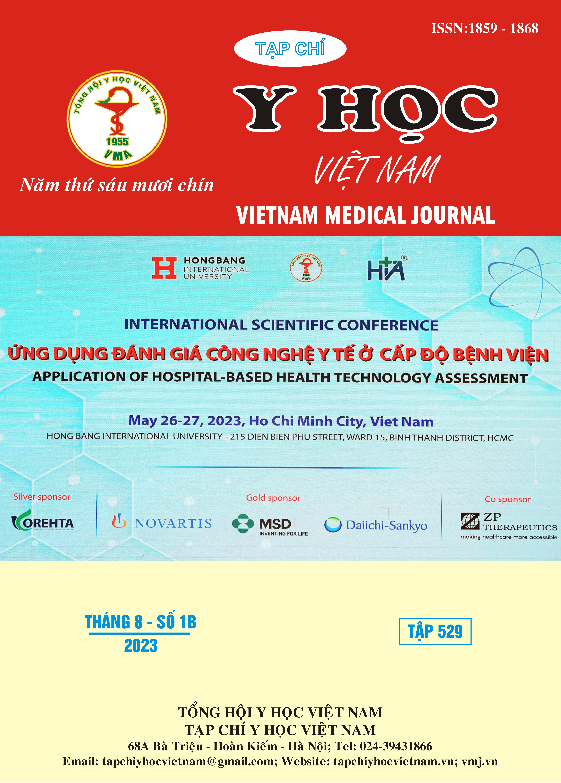CĂN NGUYÊN VI KHUẨN GÂY VIÊM PHỔI LIÊN QUAN THỞ MÁY TẠI KHOA HỒI SỨC TÍCH CỰC NGOẠI KHOA BỆNH VIỆN ĐA KHOA TỈNH THANH HÓA
Nội dung chính của bài viết
Tóm tắt
Đặt vấn đề: Tỉ lệ vi khuẩn đề kháng kháng sinh ngày càng tăng cao, lựa chọn kháng sinh ban đầu không phù hợp góp phần làm tăng tỉ lệ tử vong. Xác định căn nguyên vi khuẩn thường gặp gây VPLQTM tại đơn vị Hồi sức tích cực góp phần tối ưu dùng kháng sinh ban đầu. Mục tiêu: Xác định các căn nguyên vi khuẩn gây VPLQTM trên bệnh nhân điều trị tại khoa Hồi sức tích cực ngoại khoa Bệnh viện đa khoa tỉnh Thanh Hóa. Đối tượng và phương pháp: nghiên cứu mô tả cắt ngang trên 63 bệnh nhân được chẩn đoán VPLQTM điều trị tại khoa Hồi sức tích cực ngoại khoa bệnh viện đa khoa tỉnh Thanh Hóa từ 1/2023 đến 6/2023. Kết quả: Tỉ lệ nuôi cấy đờm, dịch phế quản dương tính 93,7%. Acinetobacter baumannii (55,9%) là căn nguyên gây bệnh chiếm tỷ lệ cao nhất, tiếp theo là Corynebacterium spp. (39%), Pseudomonas aeruginosa (23,7%), Klebsiella pneumoniae (13,6%), Staphylococcus aureus (13,6%). Hầu hết các chủng vi khuẩn đều đề kháng với nhiều loại kháng sinh. Kết luận: Ngày càng gia tăng tỷ lệ nhiễm Acinetobacter baumannii trên bệnh nhân VPLQTM, Corynebacterium spp. có thể là căn nguyên phổ biến nhưng dễ bỏ sót. Các chủng vi khuẩn gây bệnh đề kháng với nhiều loại kháng sinh.
Chi tiết bài viết
Từ khóa
Viêm phổi liên quan thở máy, căn nguyên, kháng kháng sinh, vi khuẩn
Tài liệu tham khảo
2. Allegranzi B, Nejad S. B, Combescure C, et al (2011), Burden of endemic health-care-associated infection in developing countries: systematic review and meta-analysis. The Lancet, 377(9761): 228-241
3. Bùi Hồng Giang (2013). Nghiên cứu đặc điểm vi khuẩn và điều trị nhiễm khuẩn bệnh viện tại khoa Hồi sức tích cực Bệnh viện Bạch Mai năm 2012. Luận văn Thạc sĩ Y học, Đại học Y Hà Nội
4. Võ Hữu Ngoan (2013). Nghiên cứu đặc điểm viêm phổi liên quan đến thở máy tại khoa săn sóc đặc biệt Bệnh viện Chợ Rẫy. Y Học TP. Hồ Chí Minh, Tập 17, Phụ bản số 1: 213- 219.
5. Nguyễn Thị Thanh Bình, Vũ Đình Thắng (2014). Khảo sát đặc điểm đề kháng kháng sinh của vi khuẩn gây viêm phổi bệnh viện ở bệnh nhân thở máy điều trị tại khoa HSTC – CĐ BV 115.Y Học TP. Hồ Chí Minh, tập 18, Phụ bản số 1,324 – 329
6. Nguyễn Văn Dũng, Phạm Thái Dũng (2022). Căn nguyên vi sinh và kháng kháng sinh ở người bệnh viêm phổi liên quan đến thở máy được điều trị tại khoa hồi sức tích cực bệnh viện đa khoa tỉnh Thanh Hóa. Tạp chí Y học Việt Nam. 2022;Số 1 tháng 9(518):225-230
7. CDC. Pneumonia (Ventilator-associated [VAP] and non-ventilator-associated Pneumonia [PNEU]) Event. 2019
8. Nguyễn Kim Thư, Nguyễn Danh Đức (2023), Căn nguyên vi khuẩn gây viêm phổi liên quan thở máy trên bệnh nhân điều trị tại bệnh viện đại học y Hà Nội. Tạp chí Y học Việt Nam. 2023; Số 1 tháng 4
9. Hoàng Khánh Linh. Nghiên cứu đặc điểm viêm phổi liên quan thở máy tại khoa hồi sức tích cực bệnh viện Bạch Mai giai đoạn 2017-2018: Luận văn Bác sĩ chuyên khoa cấp II, Trường Đại học Y Hà Nội; 2018.
10. Hà Sơn Bình (2015). Nhận xét một số yếu tố liên quan và hiệu quả điều trị ở bệnh nhân viêm phổi liên quan đến thở máy. Luận văn Bác sỹ chuyên khoa cấp II, Bệnh viện Bạch Mai.


